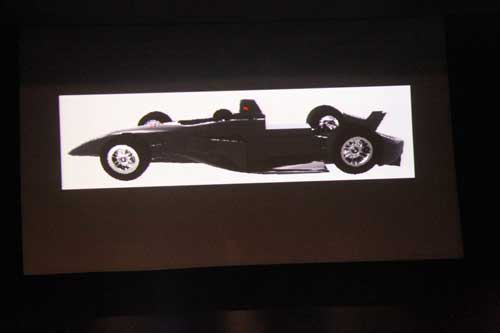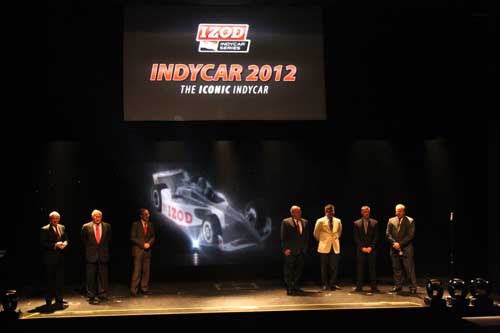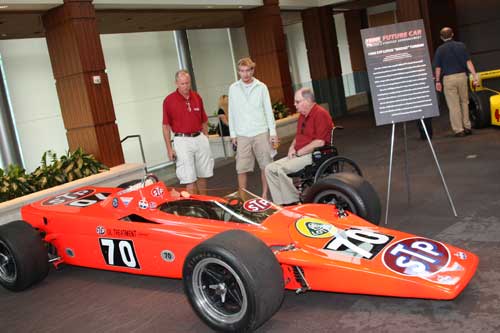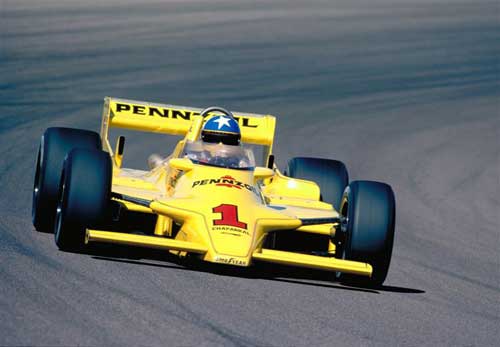July 14, 2010
IndyCar: Wishing and hoping for a brighter day, but still coming up short.
By Peter M. De Lorenzo
(Posted 7/14, 2:15PM) Detroit. Well, that was special. After months of hand-wringing, maneuvering, campaigning, speculating and wondering, IndyCar has come up with their new car strategy for the 2012 season and beyond. Unveiled at the Indianapolis Museum of Art today in a carefully orchestrated presentation that was part pep rally, part "The Apprentice," part corn pone local boosterism, and part political grandstanding event, the new car strategy revolves around a rolling chassis with an enhanced safety cell produced by - tah-dah - longtime series partner Dallara, which will be covered in changeable bodywork created by various manufacturers.
The new chassis - now officially known as the IndyCar Safety Cell - will be manufactured at a new facility in Speedway, Ind., and will serve as the base of the new car. The key differentiator, according to IndyCar, and the thing that will bring back the diversity in the look and feel of the cars, is that various manufacturers can produce an aero kit to dress the car with different body work, including front and rear wings, side pods, engine covers and more. In other words, even if Lola wanted to do a body kit, as IndyCar insists, the car could technically be referred to as a Lola IndyCar. Or, even a car manufacturer could name their car accordingly if they chose to design their own body kit.
As IndyCar reminded all of us in their presentation, the strategy is focused on the attributes of safety, raceability, cost-effectiveness, efficiency, relevant technology, American-made, green and with modern looks. (For the record, Dallara is opening a new facility in Speedway, Indiana. I guess that fulfills the "American made" part.)
The nitty-gritty of the new IndyCar?
1. Less Cost. The rolling chassis manufactured by Dallara to IndyCar specifications will cost $349,000, with a complete car costing $385,000, a 45 percent price reduction from the current IZOD IndyCar Series formula. The IndyCar Safety Cell is designed for use on all types of tracks on which the IZOD IndyCar Series competes, eliminating the need for separate chassis.
2. Two Different Aero Packages. Each team can race two different aero kits from any manufacturer during the season, with a maximum price of $70,000 for each kit. These kits must be approved by IZOD IndyCar before they're produced, and the Series must approve all aero kit parts before production. All approved aero kit parts must be made available to all teams and undergo safety testing approved by the IZOD IndyCar Series.
3. Less Weight. The targeted minimum weight for the new car is 1,380 pounds. That's nearly 200 pounds lighter than the current formula, which is a very good thing when it comes to improving the power-to-weight ratio.
4. More Safety. The IndyCar Safety Cell will feature improved visibility, head, leg and back protection and advanced padding and ergonomics. Another unique safety concept is the wheel interlock prevention system, which will allow cars to run side-by-side while limiting the chance for wheels locking and the subsequent risk for cars getting airborne.
The unveiling of the IndyCar Safety Cell completes the outline of the technical package for the IZOD IndyCar Series for 2012 and beyond. The engine technical package was announced in June, featuring specifications of a maximum of six cylinders as well as maximum displacement of 2.4 cubic liters. The ethanol-fueled engines will produce between 550 and 700 horsepower depending on the tracks used in the IZOD IndyCar Series, and will be turbocharged to allow for flexibility in power and will feature an Overtake Assist system providing a time-limited gain of up to 100 horsepower on select tracks.
So there it is. But is that all there is? It's clear that the unfortunately-named "ICONIC" committee listened first and foremost to the car owners and potential car owners. Reducing costs is a very big deal in this economically-challenged environment that exists today, so the committee did their job. But will the "free" body panel kits really provide enough diversity in look and feel to attract innovation and risk-taking? The kind that The Speedway once embraced back in its formative, more influential days?
The short answer is no.
This is a gradual, eminently responsible step. But it doesn't go far enough to really give IndyCar that jolt out of the blue that would propel it fast and furiously into The Future. So in that respect, it has to be considered a major disappointment.
Oh, and one more thing. There is one key ingredient that wasn't touched upon in today's announcement, and it's the single most crucial element that has yet to be addressed. And that is if IndyCar can't convince another engine manufacturer to come into the sport, then we're right back where we started with a glorified spec series with spec engines (Honda), and none of the buzz that this sport so desperately needed.
I'm glad the powers that be at IndyCar, the car owners and Dallara are all happy and pleased with themselves. But the end result has nothing to do with innovation and "open" competition. Instead it has everything to do with political and financial expediency.
A missed opportunity, in my book.
 (Ron McQueeney/IndyCar)
(Ron McQueeney/IndyCar)
The bare IndyCar Safety Cell.
 (Ron McQueeney/IndyCar)
(Ron McQueeney/IndyCar)
Look closely in the background and you might be able to see one of the "sample" body kits that IndyCar flashed on the large screen behind the ICONIC Committee members. IndyCar showed several different looks to emphasize how diverse the field might be. We'll see.
 (Ron McQueeney/IndyCar)
(Ron McQueeney/IndyCar)
One of the IndyCar body kit samples projected on the screen.
 (Chris Jones/IndyCar)
(Chris Jones/IndyCar)
Back when the Indianapolis Motor Speedway and Indy car racing was still all about innovation.
Publisher's Note: As part of our continuing series celebrating the "Glory Days" of racing, we're proud to present another noteworthy image from the Ford Racing Archives. - PMD
 (Courtesy of the Ford Racing Archives)
(Courtesy of the Ford Racing Archives)
Indianapolis, Indiana, 1981. Johnny "J.R." Rutherford at speed in the famed No. 1 Chaparral Cars Pennzoil Chaparral 2K/Cosworth during practice for that year's Indianapolis 500. Rutherford drove Jim Hall's ground-effects Indy car - penned by John Barnard - to the win in the previous year's "500" (1980) going away. It would be Rutherford's third and final Indianapolis 500 win. Rutherford also won the CART championship in 1980 driving the car affectionately dubbed "The Yellow Submarine."
Publisher's Note: Like these Ford racing photos? Check out ford.artehouse.com. Be forewarned, however, because you won't be able to go there and not order something. - PMD
See another live episode of "Autoline After Hours" hosted by Autoline Detroit's John McElroy, with Peter De Lorenzo and friends this Thursday evening, at 7:00PM EDT at www.autolinedetroit.tv.
By the way, if you'd like to subscribe to the Autoline After Hours podcasts, click on the following links:
Subscribe via iTunes:
http://itunes.apple.com/WebObjects/MZStore.woa/wa/viewPodcast?id=311421319
Subscribe via RSS:
http://www.autolinedetroit.tv/podcasts/feeds/afterhours-audio.xml
